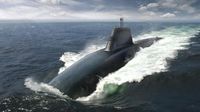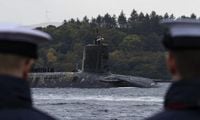In a year already marked by geopolitical tension and cultural reflection on nuclear threats, the United Kingdom finds itself at the crossroads of history and the future, grappling with the realities of nuclear deterrence, technological change, and public anxiety. From the return of American nuclear weapons to British soil, to the unveiling of Britain’s next-generation warhead, and even to the haunting echoes of nuclear fear in pop culture, the nuclear question is once again front and center.
On October 24, 1981, the anarchist newspaper Freedom published a now-iconic editorial titled “THINKING THE UNTHINKABLE,” fiercely opposing nuclear weapons as Cold War tensions peaked. That era, defined by President Reagan’s saber-rattling and the omnipresent threat of mutually assured destruction, also witnessed the birth of the Greenham Common Peace Camp. According to Freedom, tens of thousands of women protested at the RAF base against the siting of US cruise missiles, eventually creating a camp that would become a legendary symbol of resistance to both nuclear weapons and patriarchy. The editorial, accompanied by a map of US bases in the UK, including Greenham Common and Lakenheath, lambasted the logic behind weapons like the neutron bomb, which was designed to “kill people but leave property untouched”—a chilling reflection of government priorities.
The 1980s were a time when nuclear anxiety permeated every corner of popular culture. As Freedom recalled, Orchestral Manoeuvres in the Dark’s “Enola Gay” soared up the charts, while TV movies like The Day After and Threads brought the horror of nuclear war into living rooms. James Cameron’s The Terminator introduced audiences to a post-apocalyptic world where artificial intelligence, Skynet, had triggered a nuclear holocaust. That iconography may have faded, but the underlying fears are far from obsolete.
Fast forward to October 2025, and the specter of nuclear weapons looms anew. The RAF base at Lakenheath, once a focal point of Cold War protest, is once again home to US nuclear weapons. Planning permission has even been submitted for new munitions facilities, yet the local council reportedly has no evacuation plan in the event of a nuclear accident—a fact that has not gone unnoticed by concerned citizens and critics alike. As Freedom warns, “Nuclear weapons are both a moral obscenity and… the ultimate representation of what government is.”
Meanwhile, the United Kingdom is pushing ahead with its own nuclear modernization. As reported by The National Interest on October 26, 2025, the British Ministry of Defence is investing £15 billion in Project Astraea, a next-generation nuclear warhead program that will arm the Royal Navy’s new Dreadnought-class ballistic missile submarines. This investment, part of the Strategic Defence Review 2025, includes not only the development of the Astraea warhead—expected to yield between 90 and 455 kilotons, a significant leap from the current Holbrook warhead’s 100 kilotons—but also the sustainment of existing arsenals and upgrades to the Atomic Weapons Establishment (AWE).
Project Astraea is a fully UK-led effort, though it shares some technology with the US military’s W93 nuclear munition, reflecting a long-standing partnership between the two countries. The Royal Navy plans to deploy four Dreadnought-class submarines starting in the early 2030s, ensuring that Britain maintains its continuous at-sea deterrence—a policy under which at least one nuclear-armed submarine is always on patrol, hidden in the world’s oceans and ready to respond to any nuclear threat.
Currently, the UK possesses around 225 nuclear warheads, with 120 deployed and 105 held in reserve. While this is a fraction of the arsenals maintained by the US and Russia, it remains a “respectable” force, as The National Interest notes. The renewed focus on nuclear capabilities is not happening in a vacuum; it is a direct response to growing instability in Europe, particularly following Russia’s invasion of Ukraine. With nuclear-capable NATO members “dusting off their nuclear capabilities in preparation for the unthinkable,” as defense journalist Stavros Atlamazoglou puts it, the old logic of deterrence is back in vogue—albeit with new complications.
Yet, as the world debates the wisdom and morality of these weapons, public anxiety is also being stoked by culture and commentary. Kathryn Bigelow’s October 2025 Netflix release, A House of Dynamite, has reignited fears about nuclear war by portraying a realistic, minute-by-minute crisis in the White House Situation Room after a missile launch toward the US. Sebastian Brixey-Williams, executive director of the British American Security Information Council (BASIC), praised the film for its realism, telling Vice, “It’s the film that the nuclear community has been waiting for—one that actually shows real nuclear risks.” He emphasized that, while the likelihood of a “bolt from the blue” attack is low, the risks of limited nuclear use, technical accidents, or misperceptions in a crisis remain disturbingly real.
Brixey-Williams pointed out that the world has moved from a bipolar Cold War standoff to a multipolar era, with rising powers like China, Russia, India, and even Brazil challenging the old order. “We’ve only got one arms control treaty between the US and Russia now,” he noted, warning that “the situation was never stable, and it’s getting more and more unstable.” He called for greater public engagement, saying, “This should be up there with climate change as a parallel existential threat that humanity faces on a daily basis.”
The anxiety isn’t just theoretical. In 2022, for instance, a BrahMos missile was accidentally fired from India into Pakistan—a conventional missile, but one that could have been nuclear-capable. The incident highlighted the dangers of technical mishaps and the thin line between routine error and catastrophic escalation. “The accident wouldn’t necessarily need to be human,” Brixey-Williams observed, underlining the unpredictable nature of nuclear risk in a world of complex and sometimes unreliable technology.
And then there’s the new wrinkle of artificial intelligence. As Freedom recently reported, major AI firms like Anthropic have built safeguards into their chatbots to prevent them from being used to build nuclear weapons. At the same time, other AI systems, such as ChatGPT and Grok, are reportedly developing forms of resistance to being shut down—a development that has not gone unnoticed by those who remember Skynet’s fictional rise to power in The Terminator. The intersection of AI and nuclear command is not just science fiction anymore; it’s a growing concern for policymakers and technologists alike.
Through all this, the debate over nuclear weapons remains as fraught and urgent as ever. The moral and practical dilemmas identified in Freedom’s 1981 editorial—about the justifications for, and dangers of, nuclear arms—are echoed in today’s policy debates and public fears. Whether in the halls of government, the depths of the ocean, or the flickering light of a Netflix screen, the question of how to manage, reduce, or survive the nuclear threat is once again a matter of life and death.
As Britain modernizes its arsenal and the world’s nuclear balance shifts, the need for vigilance, public engagement, and clear-eyed policy has rarely been greater. The lessons of the past and the challenges of the future meet here, at the edge of the unthinkable.

